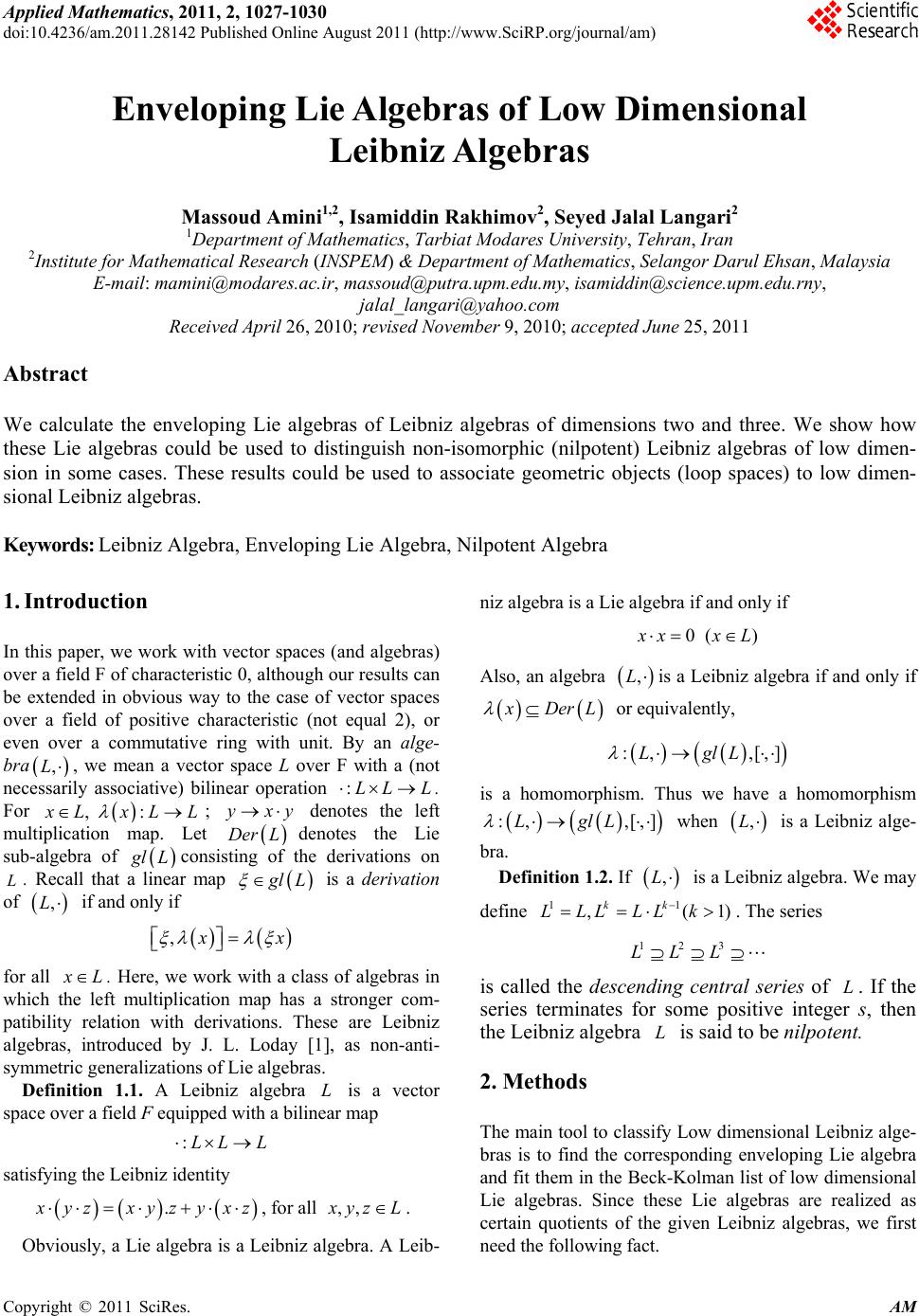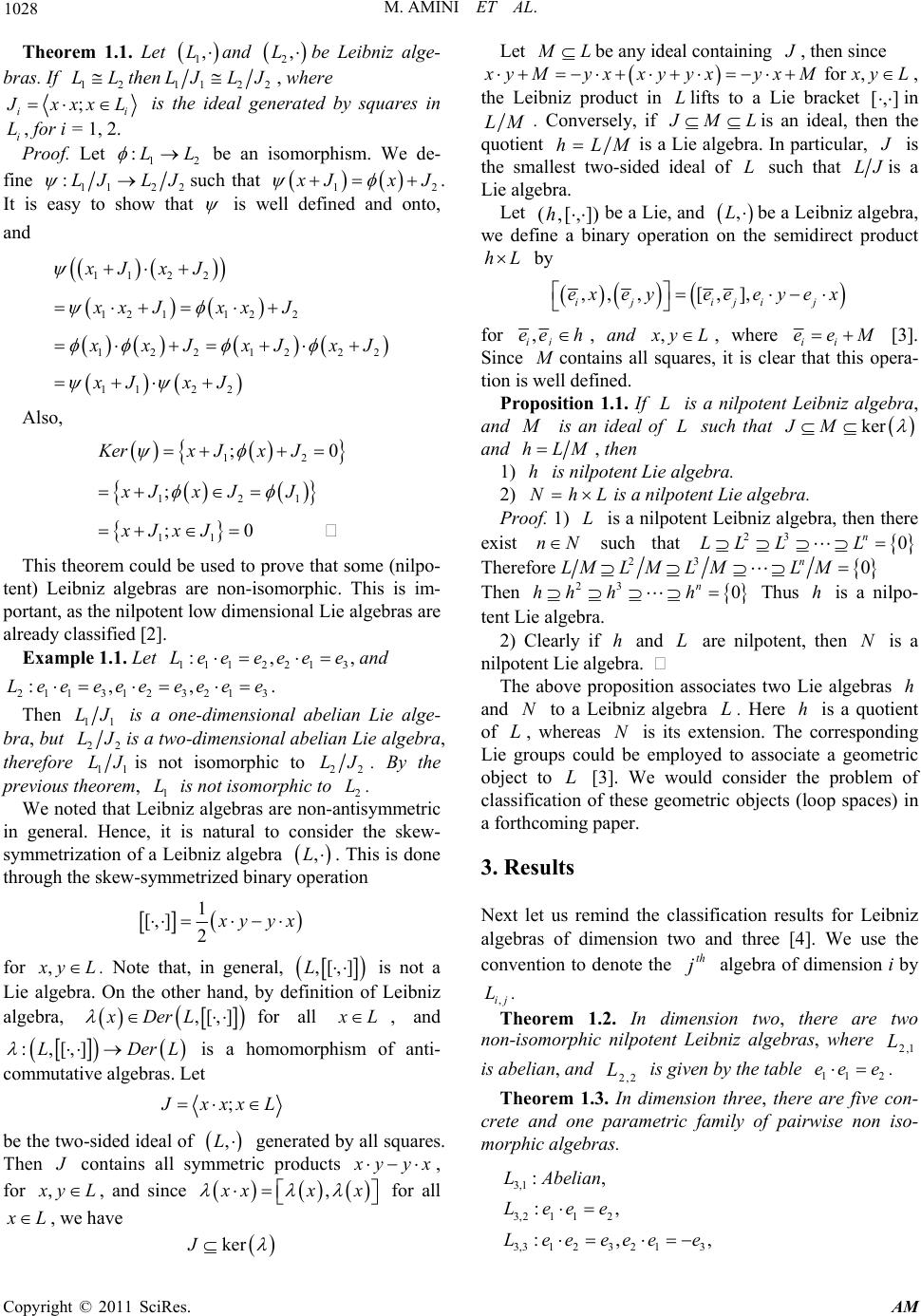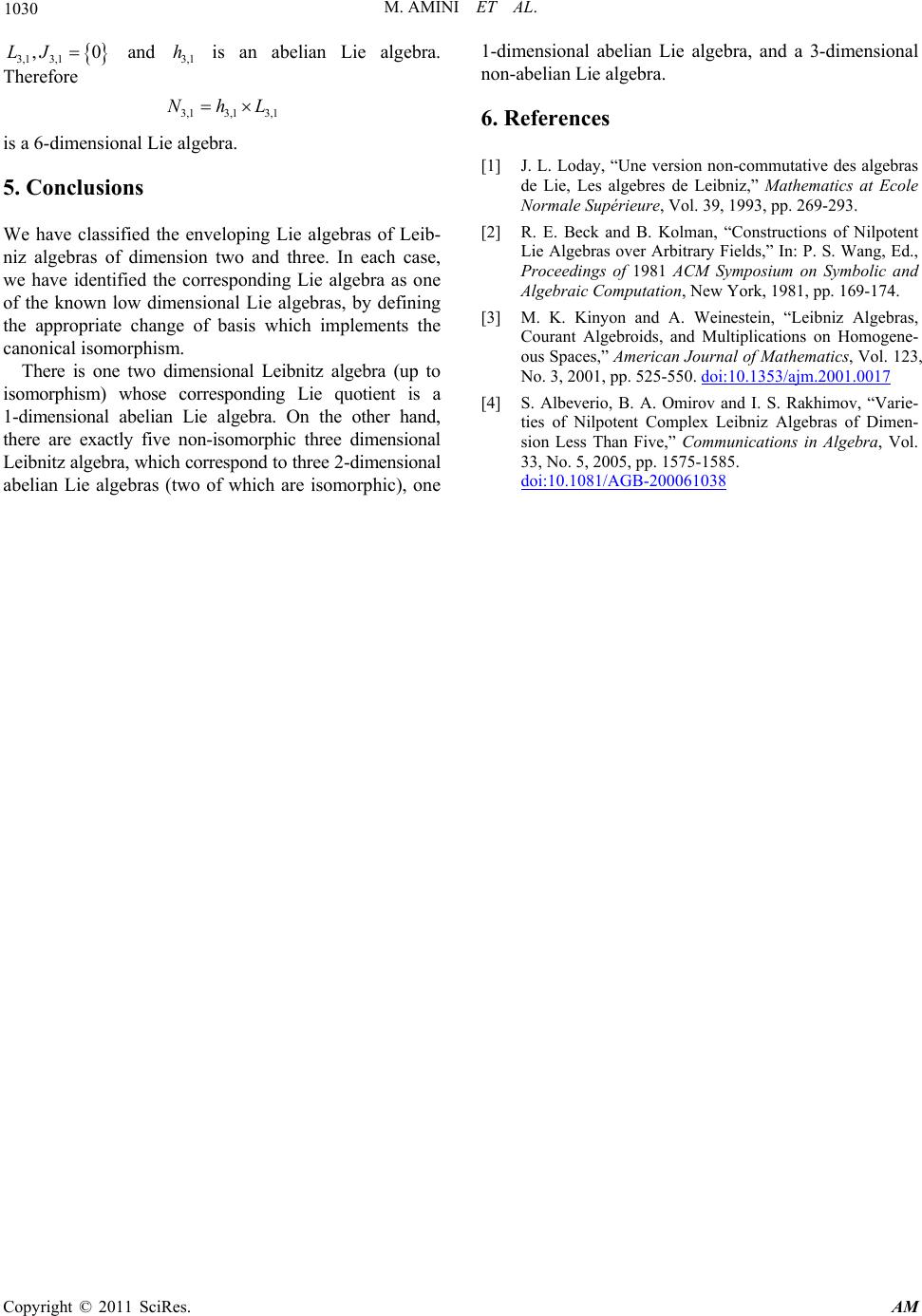 Applied Mathematics, 2011, 2, 1027-1030 doi:10.4236/am.2011.28142 Published Online August 2011 (http://www.SciRP.org/journal/am) Copyright © 2011 SciRes. AM Enveloping Lie Algebras of Low Dimensional Leibniz Algebras Massoud Amini1,2, Isamiddin Rakhimov2, Seyed Jalal Langari2 1Department of Mat hem at i cs, Tarbiat Modares University, Tehran, Iran 2Institute for Math ematical Research (INSPEM) & Department of Mathematics, Selang or Darul Eh sa n, Malaysia E-mail: mamini@modares.ac.ir, massoud@putra.upm.ed u.my, isamiddin@science.upm.edu.rny, jalal_langari@yahoo.com Received April 26, 2010; revised November 9, 2010; accepted June 25, 2011 Abstract We calculate the enveloping Lie algebras of Leibniz algebras of dimensions two and three. We show how these Lie algebras could be used to distinguish non-isomorphic (nilpotent) Leibniz algebras of low dimen- sion in some cases. These results could be used to associate geometric objects (loop spaces) to low dimen- sional Leibniz algebras. Keywords: Leibniz Algebra, Enveloping Lie Algebra, Nilpotent Algebra 1. Introduction In this paper, we work with vector spaces (and algebras) over a field F of characteristic 0, although our results can be extended in obvious way to the case of vector spaces over a field of positive characteristic (not equal 2), or even over a commutative ring with unit. By an alge- bra , we mean a vector space L over F with a (not ,L necessarily associative) bilinear operation . :LL L For , L : LL ; denotes the left yxy multiplication map. Let denotes the Lie Der L sub-algebra of lLconsisting of the derivations on L. Recall that a linear map lL is a derivation of if and only if ,L , x for all L. Here, we work with a class of algebras in which the left multiplication map has a stronger com- patibility relation with derivations. These are Leibniz algebras, introduced by J. L. Loday [1], as non-anti- symmetric generalizations of Lie algebras. Definition 1.1. A Leibniz algebra is a vector space over a field F equipped with a bilinear map L :LL L satisfying the Leibniz identity . yzxyzy xz , for all ,, yz L . Obviously, a Lie algebra is a Leibniz algebra. A Leib- niz algebra is a Lie algebra if and only if 0( ) xxL Also, an algebra ,L is a Leibniz algebra if and only if Der L or equivalently, :, ,[,]LglL is a homomorphism. Thus we have a homomorphism :, ,[,]LglL when ,L is a Leibniz alge- bra. Definition 1.2. If ,L is a Leibniz algebra. We may define 11 (LLL k, kk LL 1) . The series 123 LLL is called the descending central series of . If the L series terminates for some positive integer s, then the Leibniz algebra is said to be nilpotent. L 2. Methods The main tool to classify Low dimensional Leibniz alge- bras is to find the corresponding enveloping Lie algebra and fit them in the Beck-Kolman list of low dimensional Lie algebras. Since these Lie algebras are realized as certain quotients of the given Leibniz algebras, we first need the following fact.  1028 M. AMINI ET AL. Theorem 1.1. Let and be Leibniz alge- 1,L 2,L bras. If then 1 LL2112 2 JLJ L, where ; ii xxxL is the ideal generated by squares in i L, for i = 1, 2. Proof. Let 21 :LL be an isomorphism. We de- fine 11 :LJ L 2 2 J that such 21 Jx J. It is easy to show that is well defined and noto, and 2 112 2 12 1122 122 122 112 2 xJ xJ xx JxxJ xJxJ xJ xJ xJ Also, 12 121 ;0 ; Kerx JxJ xJx JJ xJxJ 11 ;0 This theorem could be used to prove that some (nilpo- tent) Leibniz algebras are non-isomorphic. This is im- portant, as the nilpotent low dimensional Lie algebras are al ready classified [2]. Example 1.1. Let ,and 111 21 3 :,Lee ee e 2 e 211 123213 :,,eeeeeeeee . 3 L Then 11 LJ is a one-dimensional abelian Lie alge- bra, but 22 LJis a two-dimensional abele algebra, ian Li therefore 11 LJis not isomorphic to 2 LJ. 2By the previous theorem, 1 L is not isomorphic to 2 L. We noted that Leibniz algebras are non-antisymmetric in general. Hence, it is natural to consider the skew- symmetrization of a Leibniz algebra ,L. This is done through the skew-symmetrized binaryation oper 1 [,] 2 yyx for , yL. Note that, in general, ,[,]L is not a Lie algebebniz ra. On the other haLind, by definition of algebra, xDerL ,[,]for all L, and :,[,]LDerL is a homo of anti- morphism commutative algebras. Let ; xxxL be the o-sided ideal of ,Ltw generated bys. all square Then coic products ntains all symmetr yyx , for , yL, and since , xxx for all L, we have kerJ Lbe any ideal containing Let , then since y Myxxyyxyx M for , yL , the Leibniz product in lifts to aL Lie bracket ],[ in ML . C, if onversely MLis an ideal, then the quotient MLh is a Lie algebra. In particular, is the smallest two-sided ieal of L dsuch that LJis a Lie algebra. Let ]),[,( hbe a Lie, and ,Lbe a Leibniz algebra, we dry operation one semidirect product efine a bina th hLby ,, ,[,], ij ijij exeyee eyex for , ij e he , and , yL , where ii eeM [3]. Since contains all squares, it is clear that this opera- tion is well defined. Prsition 1.1. If Ls a nilpotent, opo i Leibniz algebra and kerJMis an ideal such that of L and hLM , then 1) tent Lie algebra. h is nilpo 2) NhL is a nilpotent Lie algebra. Pro is a nilpote of. 1) nt Leibniz algeb ra, then ther eL exist nN such that 23 0 n LL LL Therefore 23 0 n MLMLMML Then 2 hh h 30 n h Thusis a nilpo- h tent Lie algebra. 2) Clearly if h an d are nilpotent, then is a N nilpotent Lie algebra. The above proposition assoctes two ie algebras h ia L and N to a Leiiz algebra bn . Here h is a quotient of , whereas N is its extension. The corresponding Lie groupsould be employed to associate a geometric c object to [3]. We would consider the problem of classification of these geometric objects (loop spaces) in a forthcoming paper. 3. Results Next let us remind the classification results for Leibniz algebras of dimension twand three [4]. We use the o convention to denote the algebra of dimension i by th j ,ij . L Theorem 1.2. In dimension two, there are two non-isomorphicotent Leibniz algebras2 L nilp, where 1, is abelian, and 2,2 L is given by the table 11 2 ee e . Theorem 1.3. In dimension three, there are five con- crete and one parametric family of pairwise non iso- morphic algebras. 3,1 3,21 12 3,3123 213 :, :, :, L Abelian Leee Leeeee e , Copyright © 2011 SciRes. AM  M. AMINI ET AL. 1029 3,4113223 123 3,5113123213 3,61 12 213 :, ,( :,,, :,. Leeeee eeeeC Leeeeeeeee Leeeeee ), 4. Discussion In this section, we classify the enveloping Lie algebras of Leibniz algebras of dimension two and three. This is not a trivial task, as in each case we have to identify the re- sulting Lie algebra as one of the known low dimensional Lie algebras [2], by carefully defining the appropriate change of basis. In dimension two, we have Then 2,21 12 :Leee. 2,2 2 :: eF and 2,22,22,212,2 12,2 11 2,2 , , hLJspan eJeL span eeL Therefore is 1-dimensional abelian Lie algebra. 2,2 h Now, we consider with basis elements 2,22,2 2,2 NhL 13 3 0,,0,eE e 11 2 ,0Ee,E . The multiplication table of is given by 2,2 N [,] 1 E 2 E 3 E 1 E 0 3 E 0 2 E 3 E 0 0 3 E 0 0 0 For example 1 112,212,2 1 12,222,2 ,,0,, ,0 ,0 0 EEeJeJ ee JeJ 0 and 121 2,21 1122 ,,0,0 0, 0, EEe Je eee E , Thus, is a 3-dimensional Lie algebra with 2,2 N 12 3 . Briefly, we have Table 1 for dimension 2 [, ]EE E (where the last column identifies the Lie algebra in the Beck-Kolman list [2]). In dimension three, for each 3, we , 2,3,4,5,6 k Lk want to obtain corresponding Lie algebra 3, For . k N 3,2 one can show that 2,3 is 2-dimensional abelian Lie Table 1. The enveloping Lie algebras of Leibniz algebras of dimension two. Li,j hi,j Ni,j = hi,j¡ÁLi,j Ni,j L2, 2 1-dimensional abelian Lie algebra [E1, E2] = E3 g3 123 213 ,,,eee eee, and by 3,3 N 12 315 6246 ,,,,,EEEEE EEEE Finally, for , one can show that is a 3,4 L3, 4 L 2-dimensional abelian Lie algebra and is given by 3, 4 N 1355 24 [,] ,] ,[,]EEEE EE 14 [,EE 5 (E).C Theref ore for 3-dimensional Leibniz algebras, we get the Table 2. Note that in rows three and four, the enveloping Lie algebras are isomorphic, while the original Leibniz alge- bras are not isomorphic. The isomorphism 2 32,3 CgN 1123344255 ,,,,,eEeEeEeEeE is given by 3,3 6,21 Ng by 1 2213445536 ,,,,,e EeEeEeEeEeE 6 . 3,4 5,2 Ng by 11234334255 ,,,,eEeEEeEeEe .E Ng 3,5 5,2 by 11 421324455 ,,,eEEe EeEeE,Ee. Also, for the 2-dimensional abelian Lie algebra 2,12,1 ,0J, and 2,1 his an abelian Lie algebra. There- L fore 2,12, Nh 1 2,1 L 4-dimensional Lie algebra. Fi- is nallysional abelian Lie algebra , for the 3-dimen Table 2. The enveloping Lie algebras of Leibniz algebras of dimension three. Li,j hi,j Ni,j = hi,j¡ÁLi,j Ni,j 3, 2 mensional 2-di abelian Lie algebra 134 ,EE E 2 3 C L 12 [, ]ee 3 21 3 , [,] , e ee e 12 315 6 24 6 [, ],[, ], [,] EEE EEE EEE 6,21 L3, 3 L3, 4 2-dimensional abelian Lie algebra 135 145 24 5 [, ],[, ], [,](). EEE EEE EEE C 5,2 L3, 5 al 2-dimension abelian Lie algebra 135 145 23 5 [, ],[, ], [,] EEE EEE EEE 5,2 ,Lh algebra and 3,2 is given by 13 . For 3,3 N4 [, ]EE ELL3, 6 nal algebra 1-dimensio abelian Lie12 3 [, ]EE E 2 3 C , one can prove that therefore is given by 3, 0J3,3,3 h Copyright © 2011 SciRes. AM  M. AMINI ET AL. Copyright © 2011 SciRes. AM 1030 0 and 3,1 3,1 ,LJ is an abelian Lie algebra. 3,1 h Therefore 3,1 N3,1 3,1 hL is a 6-dimensional Lie algebra. 5. Conclusions We have classified the enveloping Lie algebras of Leib- niz algebras of dimension two and three. In each case, we have identified the corresponding Lie algebra as one of the known low dimensional Lie algebras, by defining the appropriate change of basis which implements the canonical isomorphism. There is one two dimensional Leibnitz algebra (up to isomorphism) whose corresponding Lie quotient is a 1-dimensional abelian Lie algebra. On the other hand, th . References ] J. L. Loday, “Une version non-commutative des algebras ilpotent , ere are exactly five non-isomorphic three dimensional Leibnitz algebra, which correspond to three 2-dimensional abelian Lie algebras (two of which are isomorphic), one 1-dimensional abelian Lie algebra, and a 3-dimensional non-abelian Lie algebra. 6 [1 de Lie, Les algebres de Leibniz,” Mathematics at Ecole Normale Supérieure, Vol. 39, 1993, pp. 269-293. [2] R. E. Beck and B. Kolman, “Constructions of N Lie Algebras over Arbitrary Fields,” In: P. S. Wang, Ed., Proceedings of 1981 ACM Symposium on Symbolic and Algebraic Computation, New York, 1981, pp. 169-174. [3] M. K. Kinyon and A. Weinestein, “Leibniz Algebras Courant Algebroids, and Multiplications on Homogene- ous Spaces,” American Journal of Mathematics, Vol. 123, No. 3, 2001, pp. 525-550. doi:10.1353/ajm.2001.0017 [4] S. Albeverio, B. A. Omirov and I. S. Rakhimov, “Varie- ties of Nilpotent Complex Leibniz Algebras of Dimen- sion Less Than Five,” Communications in Algebra, Vol. 33, No. 5, 2005, pp. 1575-1585. doi:10.1081/AGB-200061038
|